Strategies to Minimise Abuse in Health and Social Care Contexts
VerifiedAdded on 2020/10/23
|7
|1183
|76
Report
AI Summary
This report focuses on safeguarding vulnerable adults in health and social care settings, emphasizing the importance of protecting them from abuse. It begins by explaining existing working practices and strategies, such as educational approaches, mental and physical exercise programs, and legislative strategies including whistleblowing policies, designed to minimize abuse. The report then evaluates the effectiveness of these practices, highlighting both their advantages and disadvantages, such as the cost-effectiveness of educational programs and the need for experienced consultants for physical exercise programs. Finally, it proposes potential improvements, including creating documented risk assessments, utilizing experienced healthcare professionals for educational approaches, and securing governmental support to enhance the effectiveness of safeguarding efforts. The report concludes by reiterating the importance of these strategies in ensuring the safety and well-being of vulnerable individuals.

SAFEGUARD LO3
Paraphrase This Document
Need a fresh take? Get an instant paraphrase of this document with our AI Paraphraser
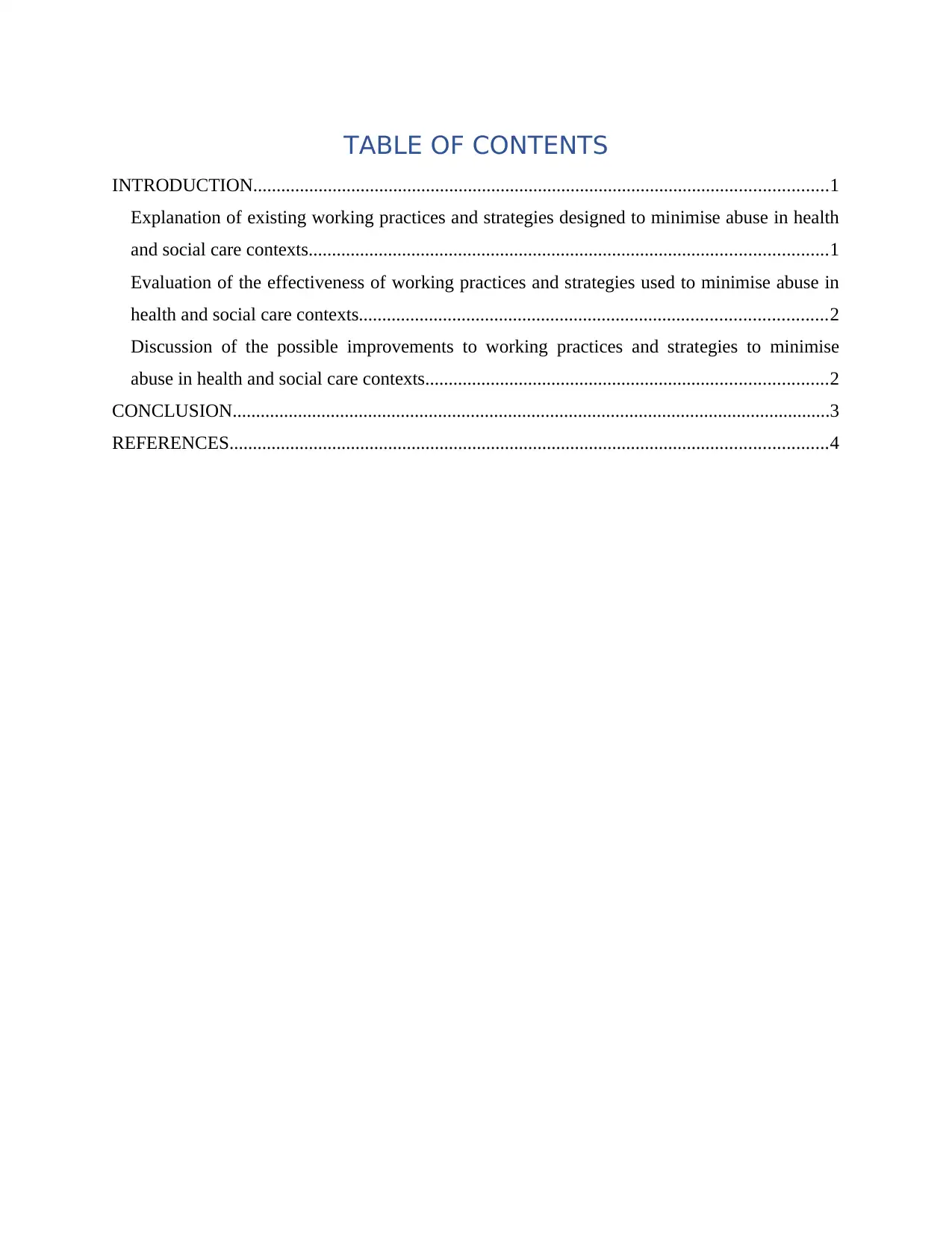
TABLE OF CONTENTS
INTRODUCTION...........................................................................................................................1
Explanation of existing working practices and strategies designed to minimise abuse in health
and social care contexts...............................................................................................................1
Evaluation of the effectiveness of working practices and strategies used to minimise abuse in
health and social care contexts....................................................................................................2
Discussion of the possible improvements to working practices and strategies to minimise
abuse in health and social care contexts......................................................................................2
CONCLUSION................................................................................................................................3
REFERENCES................................................................................................................................4
INTRODUCTION...........................................................................................................................1
Explanation of existing working practices and strategies designed to minimise abuse in health
and social care contexts...............................................................................................................1
Evaluation of the effectiveness of working practices and strategies used to minimise abuse in
health and social care contexts....................................................................................................2
Discussion of the possible improvements to working practices and strategies to minimise
abuse in health and social care contexts......................................................................................2
CONCLUSION................................................................................................................................3
REFERENCES................................................................................................................................4
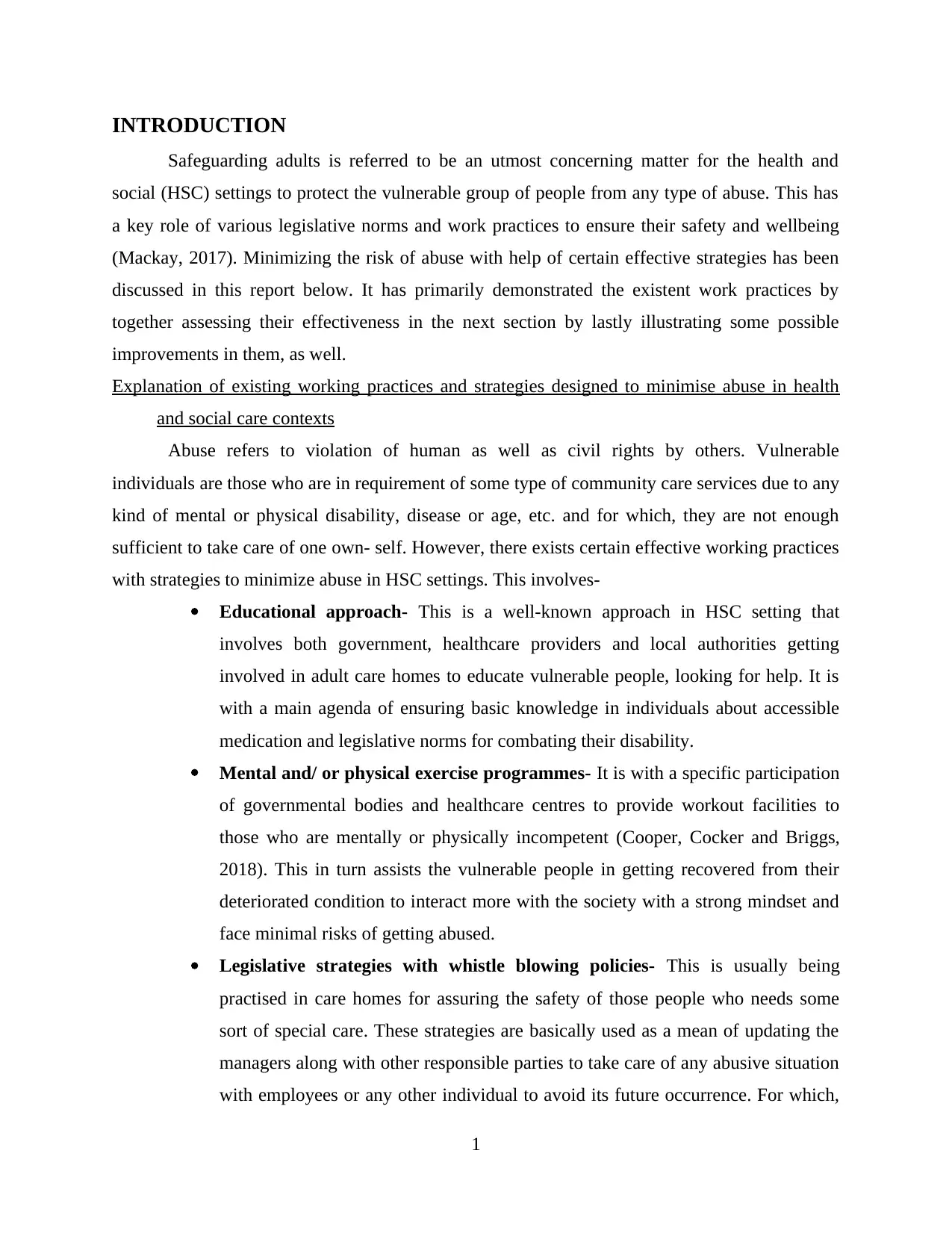
INTRODUCTION
Safeguarding adults is referred to be an utmost concerning matter for the health and
social (HSC) settings to protect the vulnerable group of people from any type of abuse. This has
a key role of various legislative norms and work practices to ensure their safety and wellbeing
(Mackay, 2017). Minimizing the risk of abuse with help of certain effective strategies has been
discussed in this report below. It has primarily demonstrated the existent work practices by
together assessing their effectiveness in the next section by lastly illustrating some possible
improvements in them, as well.
Explanation of existing working practices and strategies designed to minimise abuse in health
and social care contexts
Abuse refers to violation of human as well as civil rights by others. Vulnerable
individuals are those who are in requirement of some type of community care services due to any
kind of mental or physical disability, disease or age, etc. and for which, they are not enough
sufficient to take care of one own- self. However, there exists certain effective working practices
with strategies to minimize abuse in HSC settings. This involves-
Educational approach- This is a well-known approach in HSC setting that
involves both government, healthcare providers and local authorities getting
involved in adult care homes to educate vulnerable people, looking for help. It is
with a main agenda of ensuring basic knowledge in individuals about accessible
medication and legislative norms for combating their disability.
Mental and/ or physical exercise programmes- It is with a specific participation
of governmental bodies and healthcare centres to provide workout facilities to
those who are mentally or physically incompetent (Cooper, Cocker and Briggs,
2018). This in turn assists the vulnerable people in getting recovered from their
deteriorated condition to interact more with the society with a strong mindset and
face minimal risks of getting abused.
Legislative strategies with whistle blowing policies- This is usually being
practised in care homes for assuring the safety of those people who needs some
sort of special care. These strategies are basically used as a mean of updating the
managers along with other responsible parties to take care of any abusive situation
with employees or any other individual to avoid its future occurrence. For which,
1
Safeguarding adults is referred to be an utmost concerning matter for the health and
social (HSC) settings to protect the vulnerable group of people from any type of abuse. This has
a key role of various legislative norms and work practices to ensure their safety and wellbeing
(Mackay, 2017). Minimizing the risk of abuse with help of certain effective strategies has been
discussed in this report below. It has primarily demonstrated the existent work practices by
together assessing their effectiveness in the next section by lastly illustrating some possible
improvements in them, as well.
Explanation of existing working practices and strategies designed to minimise abuse in health
and social care contexts
Abuse refers to violation of human as well as civil rights by others. Vulnerable
individuals are those who are in requirement of some type of community care services due to any
kind of mental or physical disability, disease or age, etc. and for which, they are not enough
sufficient to take care of one own- self. However, there exists certain effective working practices
with strategies to minimize abuse in HSC settings. This involves-
Educational approach- This is a well-known approach in HSC setting that
involves both government, healthcare providers and local authorities getting
involved in adult care homes to educate vulnerable people, looking for help. It is
with a main agenda of ensuring basic knowledge in individuals about accessible
medication and legislative norms for combating their disability.
Mental and/ or physical exercise programmes- It is with a specific participation
of governmental bodies and healthcare centres to provide workout facilities to
those who are mentally or physically incompetent (Cooper, Cocker and Briggs,
2018). This in turn assists the vulnerable people in getting recovered from their
deteriorated condition to interact more with the society with a strong mindset and
face minimal risks of getting abused.
Legislative strategies with whistle blowing policies- This is usually being
practised in care homes for assuring the safety of those people who needs some
sort of special care. These strategies are basically used as a mean of updating the
managers along with other responsible parties to take care of any abusive situation
with employees or any other individual to avoid its future occurrence. For which,
1
⊘ This is a preview!⊘
Do you want full access?
Subscribe today to unlock all pages.

Trusted by 1+ million students worldwide
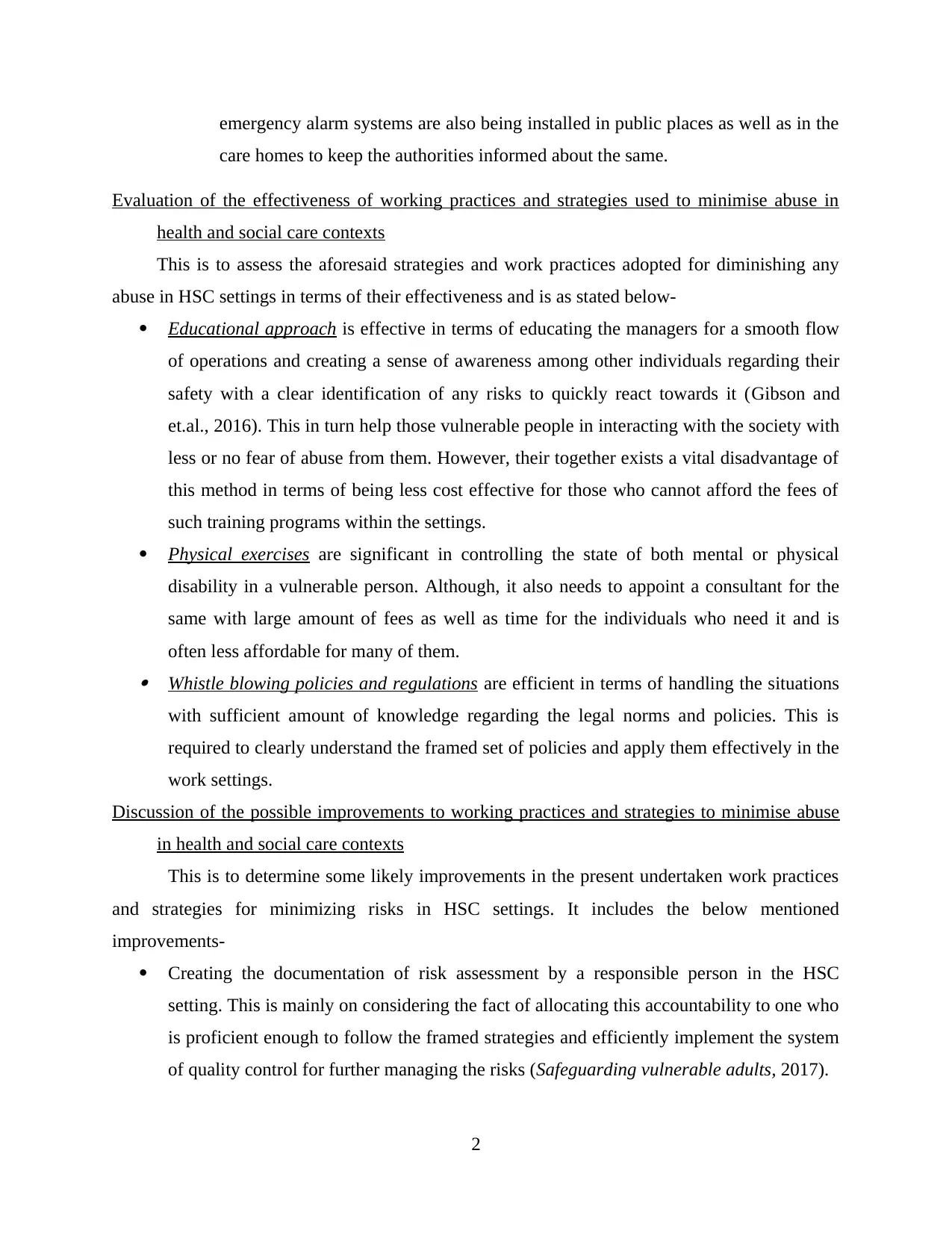
emergency alarm systems are also being installed in public places as well as in the
care homes to keep the authorities informed about the same.
Evaluation of the effectiveness of working practices and strategies used to minimise abuse in
health and social care contexts
This is to assess the aforesaid strategies and work practices adopted for diminishing any
abuse in HSC settings in terms of their effectiveness and is as stated below-
Educational approach is effective in terms of educating the managers for a smooth flow
of operations and creating a sense of awareness among other individuals regarding their
safety with a clear identification of any risks to quickly react towards it (Gibson and
et.al., 2016). This in turn help those vulnerable people in interacting with the society with
less or no fear of abuse from them. However, their together exists a vital disadvantage of
this method in terms of being less cost effective for those who cannot afford the fees of
such training programs within the settings.
Physical exercises are significant in controlling the state of both mental or physical
disability in a vulnerable person. Although, it also needs to appoint a consultant for the
same with large amount of fees as well as time for the individuals who need it and is
often less affordable for many of them. Whistle blowing policies and regulations are efficient in terms of handling the situations
with sufficient amount of knowledge regarding the legal norms and policies. This is
required to clearly understand the framed set of policies and apply them effectively in the
work settings.
Discussion of the possible improvements to working practices and strategies to minimise abuse
in health and social care contexts
This is to determine some likely improvements in the present undertaken work practices
and strategies for minimizing risks in HSC settings. It includes the below mentioned
improvements-
Creating the documentation of risk assessment by a responsible person in the HSC
setting. This is mainly on considering the fact of allocating this accountability to one who
is proficient enough to follow the framed strategies and efficiently implement the system
of quality control for further managing the risks (Safeguarding vulnerable adults, 2017).
2
care homes to keep the authorities informed about the same.
Evaluation of the effectiveness of working practices and strategies used to minimise abuse in
health and social care contexts
This is to assess the aforesaid strategies and work practices adopted for diminishing any
abuse in HSC settings in terms of their effectiveness and is as stated below-
Educational approach is effective in terms of educating the managers for a smooth flow
of operations and creating a sense of awareness among other individuals regarding their
safety with a clear identification of any risks to quickly react towards it (Gibson and
et.al., 2016). This in turn help those vulnerable people in interacting with the society with
less or no fear of abuse from them. However, their together exists a vital disadvantage of
this method in terms of being less cost effective for those who cannot afford the fees of
such training programs within the settings.
Physical exercises are significant in controlling the state of both mental or physical
disability in a vulnerable person. Although, it also needs to appoint a consultant for the
same with large amount of fees as well as time for the individuals who need it and is
often less affordable for many of them. Whistle blowing policies and regulations are efficient in terms of handling the situations
with sufficient amount of knowledge regarding the legal norms and policies. This is
required to clearly understand the framed set of policies and apply them effectively in the
work settings.
Discussion of the possible improvements to working practices and strategies to minimise abuse
in health and social care contexts
This is to determine some likely improvements in the present undertaken work practices
and strategies for minimizing risks in HSC settings. It includes the below mentioned
improvements-
Creating the documentation of risk assessment by a responsible person in the HSC
setting. This is mainly on considering the fact of allocating this accountability to one who
is proficient enough to follow the framed strategies and efficiently implement the system
of quality control for further managing the risks (Safeguarding vulnerable adults, 2017).
2
Paraphrase This Document
Need a fresh take? Get an instant paraphrase of this document with our AI Paraphraser
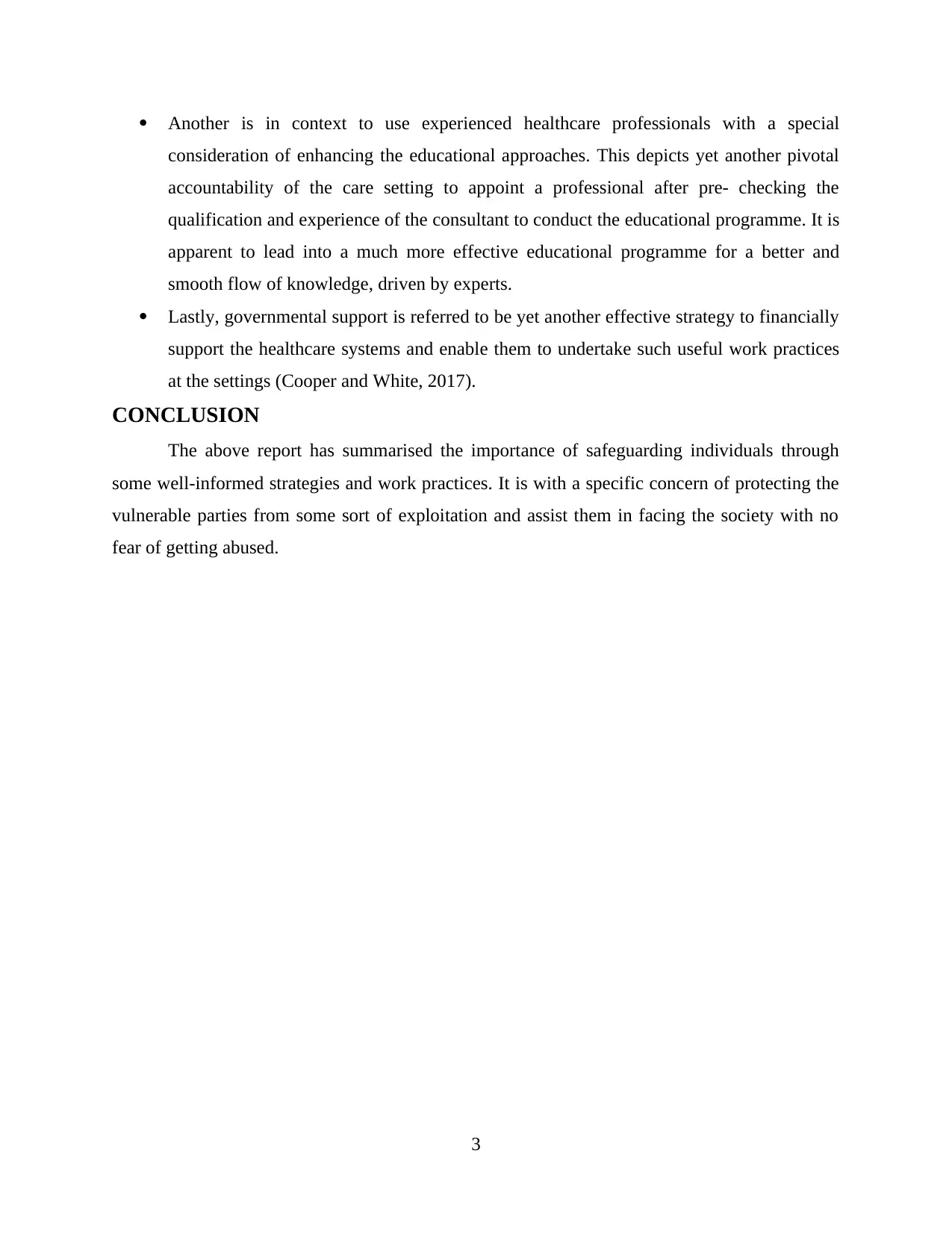
Another is in context to use experienced healthcare professionals with a special
consideration of enhancing the educational approaches. This depicts yet another pivotal
accountability of the care setting to appoint a professional after pre- checking the
qualification and experience of the consultant to conduct the educational programme. It is
apparent to lead into a much more effective educational programme for a better and
smooth flow of knowledge, driven by experts.
Lastly, governmental support is referred to be yet another effective strategy to financially
support the healthcare systems and enable them to undertake such useful work practices
at the settings (Cooper and White, 2017).
CONCLUSION
The above report has summarised the importance of safeguarding individuals through
some well-informed strategies and work practices. It is with a specific concern of protecting the
vulnerable parties from some sort of exploitation and assist them in facing the society with no
fear of getting abused.
3
consideration of enhancing the educational approaches. This depicts yet another pivotal
accountability of the care setting to appoint a professional after pre- checking the
qualification and experience of the consultant to conduct the educational programme. It is
apparent to lead into a much more effective educational programme for a better and
smooth flow of knowledge, driven by experts.
Lastly, governmental support is referred to be yet another effective strategy to financially
support the healthcare systems and enable them to undertake such useful work practices
at the settings (Cooper and White, 2017).
CONCLUSION
The above report has summarised the importance of safeguarding individuals through
some well-informed strategies and work practices. It is with a specific concern of protecting the
vulnerable parties from some sort of exploitation and assist them in facing the society with no
fear of getting abused.
3
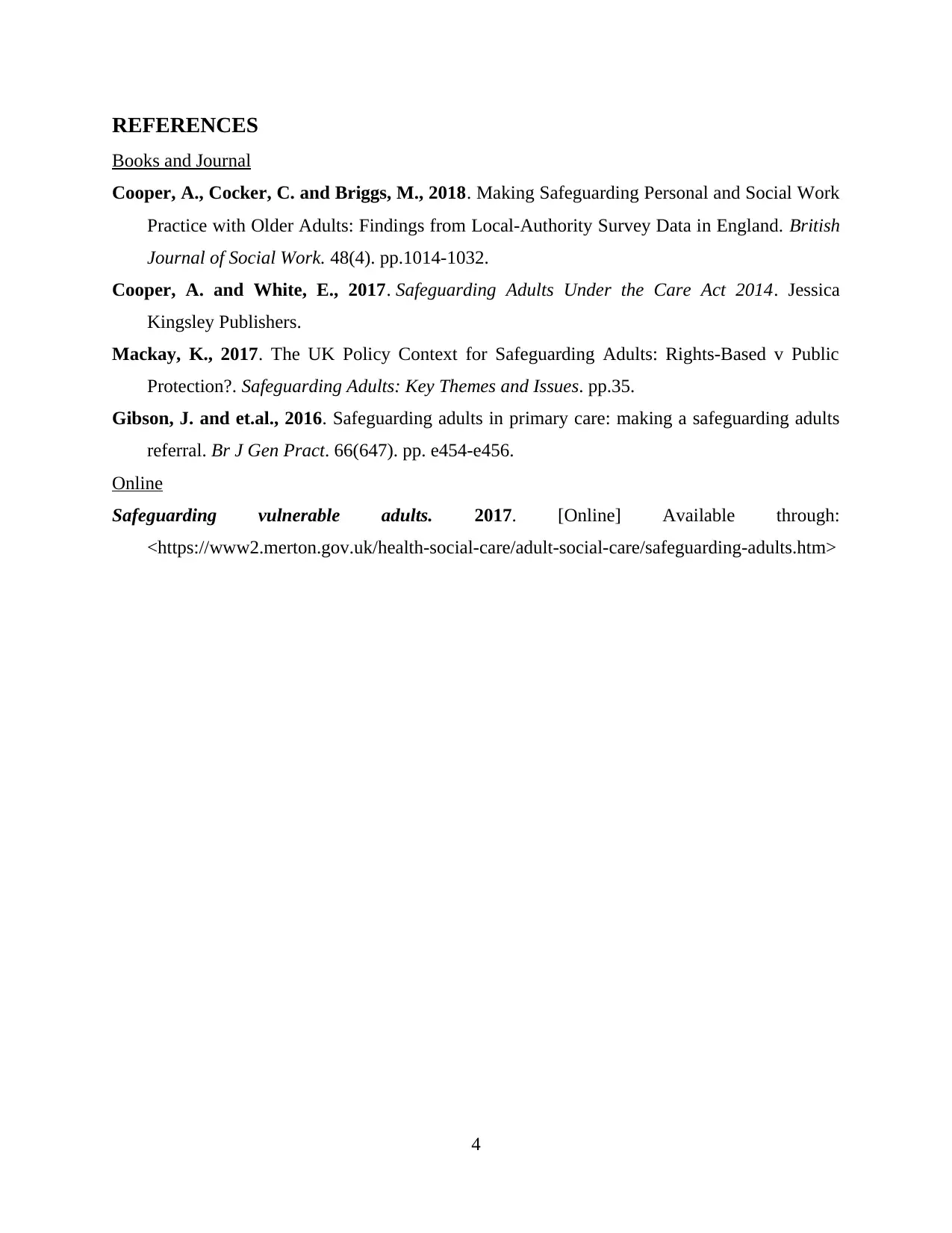
REFERENCES
Books and Journal
Cooper, A., Cocker, C. and Briggs, M., 2018. Making Safeguarding Personal and Social Work
Practice with Older Adults: Findings from Local-Authority Survey Data in England. British
Journal of Social Work. 48(4). pp.1014-1032.
Cooper, A. and White, E., 2017. Safeguarding Adults Under the Care Act 2014. Jessica
Kingsley Publishers.
Mackay, K., 2017. The UK Policy Context for Safeguarding Adults: Rights-Based v Public
Protection?. Safeguarding Adults: Key Themes and Issues. pp.35.
Gibson, J. and et.al., 2016. Safeguarding adults in primary care: making a safeguarding adults
referral. Br J Gen Pract. 66(647). pp. e454-e456.
Online
Safeguarding vulnerable adults. 2017. [Online] Available through:
<https://www2.merton.gov.uk/health-social-care/adult-social-care/safeguarding-adults.htm>
4
Books and Journal
Cooper, A., Cocker, C. and Briggs, M., 2018. Making Safeguarding Personal and Social Work
Practice with Older Adults: Findings from Local-Authority Survey Data in England. British
Journal of Social Work. 48(4). pp.1014-1032.
Cooper, A. and White, E., 2017. Safeguarding Adults Under the Care Act 2014. Jessica
Kingsley Publishers.
Mackay, K., 2017. The UK Policy Context for Safeguarding Adults: Rights-Based v Public
Protection?. Safeguarding Adults: Key Themes and Issues. pp.35.
Gibson, J. and et.al., 2016. Safeguarding adults in primary care: making a safeguarding adults
referral. Br J Gen Pract. 66(647). pp. e454-e456.
Online
Safeguarding vulnerable adults. 2017. [Online] Available through:
<https://www2.merton.gov.uk/health-social-care/adult-social-care/safeguarding-adults.htm>
4
⊘ This is a preview!⊘
Do you want full access?
Subscribe today to unlock all pages.

Trusted by 1+ million students worldwide

5
1 out of 7
Related Documents
Your All-in-One AI-Powered Toolkit for Academic Success.
+13062052269
info@desklib.com
Available 24*7 on WhatsApp / Email
![[object Object]](/_next/static/media/star-bottom.7253800d.svg)
Unlock your academic potential
Copyright © 2020–2025 A2Z Services. All Rights Reserved. Developed and managed by ZUCOL.





